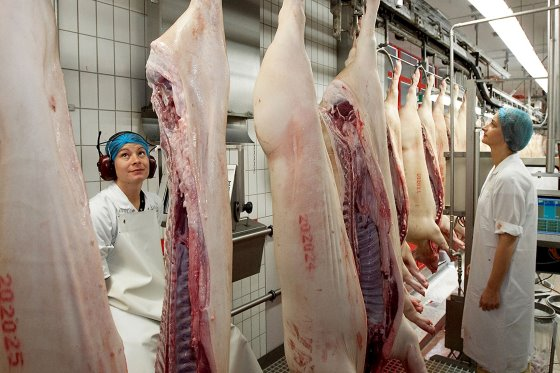来源:Pig Progress
The analysis of meat inspection data at slaughter suggests availability of genetic variation for most common indicators of poor animal welfare. That way, genetic selection can be a tool in reducing the risk of diseases, thereby reducing pain and suffering of animals.
对屠宰肉类检验数据的分析表明,对于最常见的动物福利不佳的指标,通过遗传变异加以辨认的可能性。如此一来,基因选择可以用于降低疾病风险,从而减少生猪遭受的痛苦。
Meat inspection data along with the genetic selection for economically important production traits can be used to enhance animal welfare, so much became clear from a recent publication in the peer-reviewed journal Animals. Researchers from breeding company Topigs Norsvin and Wageningen University & Research, the Netherlands, delved deeper into this topic*. The article was published in early 2018.
肉类检验数据以及对经济上具有重要意义的生产性状的遗传选择可用于提高动物福利,最近在同行评审期刊《动物》上发表的一篇文章就清楚地表明了这一点。来自育种公司Topigs Norsvin和荷兰瓦赫宁根大学和研究所的研究人员深入探讨了这个话题*。该文章发表于2018年初。
The researchers wrote that in many slaughter plants, animal health and welfare are monitored during meat inspection at slaughter. Carcasses are usually examined by meat inspectors and remarks are made with respect to different diseases, injuries and other abnormalities. Those data are also valuable for disease prevention and enhancing animal welfare but are rarely used for that purpose. The researchers therefore set up the following trial.
研究人员写道,在许多屠宰厂中,屠宰时的肉类检查过程中可以检测动物的健康和福利状况。猪胴体通常由肉类检查员进行检查,并就不同的疾病、伤害和其他异常情况作出评论。这些数据对疾病预防和提高动物福利也很有价值,但甚少用于此目的。因此,研究人员做了以下试验。

Carcass inspection in full swing at a German slaughterhouse. This picture was not taken in the context of the research described in the article. Photo: Ronald Hissink
德国一家屠宰场正在进行猪胴体全面检查。图片与本文所述研究无关。
The trial
试验过程
The scientists analysed data on carcass slaughter remarks of 140,375 finisher pigs to investigate the possibility of genetic selection to reduce the risk of the most prevalent diseases and indicators of sub-optimal animal welfare. These pigs came from slaughter plants in Germany, between 2011 and 2016. The animals came from 13 farms in Germany and the Netherlands, and were given the names ‘Farm A’ until ‘Farm M’.
科学家们分析了140375头猪的胴体屠宰数据,以研究遗传选择的可能性,以降低最常见疾病的风险,同时研究次优动物福利指标。2011年至2016年间,这些数据来自德国的屠宰场,猪来自德国和荷兰的13个农场,按照字母顺序进行命名,从“农场A”,至“农场M”。
The researchers also examined effects of non-genetic factors such as differences between farms, sexes and growth rates. The most frequent slaughter remarks were pneumonia (15.4%), joint disorders (9.8%), pleuritis (4.7%), pericarditis (2.3%) and liver lesions (2.2%). Pedigree records were available; those data the team used for genetic analysis.
研究人员还研究了非遗传因素的影响,例如不同农场、性别和生长率之间的差异。最常见的屠宰评论是肺炎(15.4%)、关节疾病(9.8%)、胸膜炎(4.7%)、心包炎(2.3%)和肝脏病变(2.2%)。有可用的系谱记录;研究小组用于遗传分析的数据。
Animal welfare disorders
动物福利问题
In total, the research team analysed 5 conditions as indicators of poor health and sub-optimal animal welfare.
总的来说,研究小组分析了5种情况,作为不良健康状况和次优动物福利的指标。
1. Pneumonia: An inflammation of the tissues of the lungs. It is mainly caused by viruses, bacteria, or fungi.
2. Pleuritis: Inflammation of the tissue layers (pleura) lining the lungs and inner chest wall. It causes breathing difficulties for pigs.
3. Pericarditis: Inflammation of the pericardium, the fibrous sac surrounding the heart; this sac holds the heart in place to maintain its proper functioning.
4. Liver lesions: Liver lesions are mainly caused by parasitic infections. White spots, also called milk spots, are observed in the liver of affected pigs.
5. Joint disorders: This includes bursitis and other disorders leading to inflammation of joints. The bursa is a sac filled with lubricating fluid, located between bone, muscle, tendons, and skin to decrease rubbing, friction and irritation. Joint disorders cause pain and difficulty in walking for the animal, indicating poor animal health and welfare.
1.肺炎:肺部组织的炎症。主要由病毒、细菌或真菌引起。
2.胸膜炎:肺部和胸腔内壁组织层(胸膜)的炎症。它会给猪造成呼吸困难。
3.心包炎:心包的炎症,心包是围绕心脏的纤维囊;这个囊将心脏固定在适当的位置,以维持其正常功能。
4.肝脏病变:肝脏病变主要由寄生虫感染引起。在受感染猪的肝脏中可观察到白斑,也称为乳斑。
5.关节疾病:包括滑囊炎和其他导致关节炎的疾病。法氏囊是一种充满润滑液的囊,位于骨骼、肌肉、肌腱和皮肤之间,以减少摩擦、摩擦和刺激。关节紊乱会导致动物疼痛和行走困难,表明动物健康和福利不佳。
Trial results
试验结果
The researchers found that differences exist between farms with respect to the incidences of the slaughter remarks observed at the slaughter plant. Those differences might help to understand the predisposition of pigs to certain health or welfare disorders.
研究人员发现,在屠宰厂观察到的屠宰数据发生率方面,农场之间存在差异。这些差异可能有助于了解猪的某些健康或福利问题的原因。
In the study, pneumonia and joint disorders had highest incidences, the researchers wrote in their article. Comparing farms with highest number of pigs, ‘Farm L’ with slower growth rate had higher average incidence for joint disorder (13.1%) than ‘Farm M’ (6.1%) which had a faster growth rate. That might suggest that leaner pigs could have higher joint disorders as will be discussed under the section of ‘genetic correlations with production traits’.
研究人员在文章中写道,在这项研究中,肺炎和关节紊乱的发病率最高。与猪数量最多的农场相比,生长速度较慢的“农场L”的关节紊乱平均发病率(13.1%)高于生长速度较快的“农场M”(6.1%)。这可能意味着瘦猪可能有更高的关节疾病患病率,这将在“生产性状的遗传相关性”一节中讨论。
(文/爱猪网记者刘坤颖编译,爱猪网原创,转载请注明出处!)










